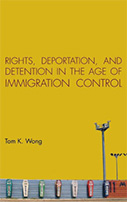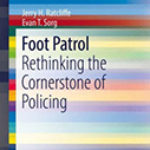Rights, Deportation, And Detention In The Age Of Immigration Control

Author: Tom K. Wong
Publisher: Stanford, CA: Stanford University Press, 2015. 256p.
Reviewer: David Hernández | March 2018
Tom K. Wong’s Rights, Deportation, and Detention in the Age of Immigration Control engages the vexed issue of migration enforcement among immigrant-receiving nations in Europe and North America. In the introduction, Wong explores the concept of Westphalian sovereignty as the “conceptual pillar” (4) that provides nations the authority to control immigration in terms of entry, exit, citizenship, and expulsion. He interrogates the seemingly monolithic trend toward restrictionism, in the name of territorial sovereignty, which Wong suggests need not be the solitary policy outcome.
Versed in the disciplinary empiricism of political science, Wong wants to “disassemble” (6) the machinery of immigration control and apply “comparable metrics” to measure immigration control across time and nations. He covers 25 countries in Europe and the U.S. over ten years (8). The study also includes in-depth interviews and participant observation of enforcement practices, but this data is often relegated to epigraphs at the start of chapters. Rich but brief historical examples of migration control worldwide punctuate advance sections of the various chapters, adding to his comparative lens.
Wong positions his book against an immigration control literature that he suggests is limited to border policing and exclusion policies. This seems to be a product of his disciplinary purview. Detention and deportation enjoy a burgeoning literature in other social sciences as well as history, ethnic studies, gender and sexuality studies, and other fields that bring to bear analyses of race and racial animus that are often central organizing principles of migration control. Wong teases out some of these issues in his analysis of three central elements of immigration control mentioned in the title, which Wong argues are the “bedrock of the contemporary machinery of immigration control” (9). These are: 1) the contingent rights of noncitizens; 2) forced removal, or deportation; and 3) incarceration via detention.
Wong meaningfully addresses human rights regimes and supranational orders/rulings, discourses, and goals. He explores the “chasmal gaps” (28) that exist between the discourse and promise of human rights and how nations support or implement such practices in their immigration policies. Focusing on the International Convention on the Protection of the Rights of All Migrant Workers and Members of Their Families (ICRMW) and nations’ likeliness or reluctance to ratify the convention, Wong observes that the ICRMW, with 45 of 192 members on board, is “one of the most poorly ratified human rights treaties” (35).
He tests empirically sovereign nations’ “intractable reluctance” (37) to accept supranational agreements on the rights of migrants between 1990 and 2009. This reluctance, Wong argues, is due to the “sovereignty costs” of ratification (28)—or, the perceived limitations to national priorities. “Sovereignty costs” are more than just a scholarly observation, but the “greatest impediment to ratification of the ICRMW” (50), writes Wong, as well as the broader extension of guaranteed rights and protections to migrants. Such caution can result in futility when international authorities condemn the actions and violations of immigrant-receiving nations. In the end, while there is evidence of human rights regimes’ impacts, especially, discursively, substantive changes to national policies—with the exception of the trend toward restrictionism—have been slow, at best.
The book’s examination of deportation demonstrates the volatility of immigration politics and the inconclusiveness of predictors of pro- or anti-immigrant policies. For example, Wong is wary of economic determinism as the key driver of migration and deportation, pointing to examples that challenge this status quo. Other metrics examined with multivariate statistical methods are equally inconclusive in their predictive value—size of foreign-born populations, ideological leadership of nations, electoral representation, unemployment, and others. Despite the variability in deportation metrics, Wong’s macro data illustrates that the U.S. share of deportations climbed steadily beginning in 2000 while the European Union’s declined (85). As well, even small right- wing presence can impact immigration policy politically and is more decisive as the share of electoral apportionment among the right grows.
Focusing also on detention—the “understudied cog” (24) of deportation regimes—Wong explores various aspects of detention (conditions, abuse, deaths, standards, etc.), discerning “front-end” (upon entry and often for asylum seekers) and “back-end” detention (upon removal) (111). He explores the principle of proportionality, used to challenge migrant incarceration as a serious deprivation of liberty and to promote alternatives to detention.
While generally considered an intermediary process pursuant to removal, detention systems hinge on a complex system of identifying undocumented persons, which is heavily influenced by racial stereotypes and profiling. “Presuming illegality and establishing illegality are distinct aspects of the identification problem,” Wong suggests (114). Cross-national variation in carceral conditions occurs even when certain elements like detention standards are uniform, largely because standards in the nations under study are non-binding. Similarly, human rights challenges to national enforcement systems are restricted by nations’ own rules for detention, often mandatory (including a bed mandate or minimum quota in the U.S.), and unwillingness to cede sovereign control.
Wong takes on the important question of migration control and its deterrent effect for new and repeat migration. Sovereign nations make the claim that detaining and deporting migrants is meant to deter legal defenses of existing detainees and future migrations. While not an implausible rationale, and certainly ripe for manipulation in the electoral process, Wong is clear that the deterrence or attrition pressure on migration simply does not address the root causes of migration. “Migrants are not merely political objects whose actions always comport to the whims of policymakers,” Wong writes (146). Whether it’s the ‘cat and mouse’ game of border enforcement, or the increased financial and social costs of migration and settlement, migrants either innovate or absorb the costs of migration enforcement in relation to their original motivations to relocate. As a result, migrants and asylum-seekers are largely undeterred by increased enforcement.
Rights, Deportation and Detention offers a complex view of U.S. and European deportation regimes set in the context of global migration. This complexity renders many of the findings inconclusive and the larger labyrinthine regimes difficult to compare. For example, to determine capacity, do you measure the number of detention sites or detention beds, the number of detainees or their days in detention? What happens when a detention center comingles detainees with persons in the criminal justice system? How do you count these hybrid sites? There is always more complexity to explore in this critical can of worms that Wong is prying open. For example, when the author refers to the “left-leaning Obama administration” (131) he doesn’t mention the right-leaning U.S. Congress and the all- out effort to obstruct Obama during his administration. Nonetheless, instead of forcing comparisons of data lacking statistical significance, the author instead presents the complexity as a whole—his key and critical finding—and points to areas that merit further scrutiny. These potential answers to stubborn questions reflect Wong’s future research agenda.
Some of these areas, as Wong suggests, might be located in stronger data for unauthorized migration across nations. I would also suggest an analysis of various kinds of removal beyond formal deportation proceedings, to include other formalized “returns” as well as coerced repatriations. In the very useful analysis of nations’ relationships with human rights institutions, there may also be cases of apples being compared to oranges. In many ways, perhaps the U.S. is exceptional in some ways, not in its racial anxieties about migrants, but in its relations with other nations and supranational powers, including its lurch into isolationism under recent administrations. As well, whereas Wong notes that none of the policy initiatives explored deal with the roots of migration and asylum-seeking, it’s clearly worth exploring why people are fleeing their countries of origin and what role does Europe and the U.S. play in sustaining these movements?
David Hernández, Assistant Professor, Latina/o Studies, Mount Holyoke College


